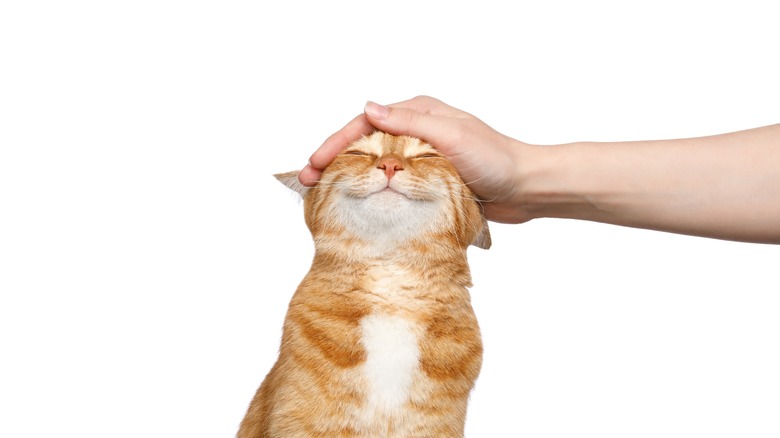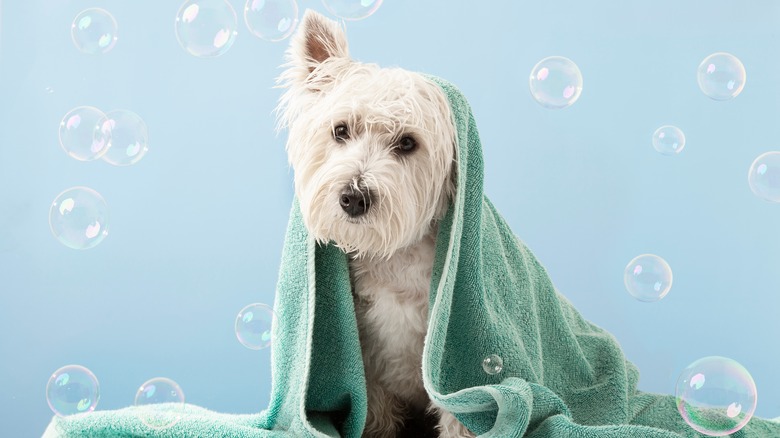How To Protect Your Furniture Without Harming Your Pets, According To An Expert
Pets are an ever-present part of many homes. The American Veterinary Medical Association reports that roughly 64% of U.S. households have at least one cat or dog as a member of the family (with an additional 2.8% of homes playing host to birds). With almost 80 million dogs and 60 million cats at home across the country, collectively, chances are that you or someone you know has to contend with pets on the furniture. Specifically, homes that support four-legged wanderers are likely to contend with increased cleaning demands due to excess fur and dirt.
In an exclusive interview with House Digest, Dr. Paola Cuevas Moreno, a Veterinarian, MVZ, and Behaviorist with Pet Keen provides her expert take on keeping the house clean and sanitary while prioritizing the health of your beloved pets. "Thinking ahead goes a long way when protecting your belongings from your pets," Cuevas Moreno says. Thus, a solid plan for managing pets and furniture is crucial when balancing the features of a modern, pet-friendly home.
Give pets their own furniture and space
Pets need their own space for a happy and healthy life. If you don't offer these options, your pets will look to your furniture as their own, potentially adding tufts of hair, scratch marks, and other issues to the items. "If you give a dog a chew toy and a cat a stretching post and a climbing tree, your furniture is much more likely to remain free of pet damage. Animals will always look for opportunities to behave as their species naturally does, and providing several possibilities and alternatives goes a long way," Dr. Cuevas Moreno says.
Dogs and cats are all unique, so no two pets will gravitate toward the same kinds of bedding. Trying out a few different options will give you a sense of the types that best grant comfort and calmness to your pet. "Make sure your pets have a comfortable space designated as their own. A dog that has a dog bed in the living room is less likely to take over the sofa as a lounging area," Dr. Cuevas Moreno says. "Provide a cat with a cozy, partially-covered higher-up hiding/sleeping area."
Of course, your sofa may require special attention, especially if you're a cat owner. "For cats that have already developed the terrible habit of scratching the sofa sides, you could try anti-scratch deterrent barrier tape or use a sofa protector scratcher," Dr. Cuevas Moreno says.
Use a deterrent spray
Other methods can be employed if your pets are determined to assert their presence on the sofa, even with a comfortable bed or scratching post in the home. Ultimately, training your dog or cat to stay off the furniture is a matter of determination. "If you do not allow your pets on the sofa, then make sure you are clear about that during every attempt they make. Pets can be a bit stubborn, so adding some deterrent spray might be needed in some cases," Dr. Cuevas Moreno says.
These act as a gentle guide for your pet to alter its behavior and can be immensely beneficial if you are working on training a particularly determined cat or dog. "If a regular deterrent spray does not work, other methods to try are motion detection sprays. These devices detect your pet's movement within a 3-feet radius of its off-limit zone. If your pet approaches, the spray will surprise them by releasing a brisk but harmless spray. PetSafe SSSCAT Spray Deterrent & Repellent for Cats & Dogs would be my recommendation," Dr. Cuevas Moreno adds.
Be clear about the rules
In addition to physical cues, verbal and behavioral consistency is crucial. "Rules should be black and white," Dr. Cuevas Moreno says. "If you do not want to see your dog on the sofa, you should never allow it." Consistency is vital to any training regimen, especially if you are trying to train a pet that you've had for a while. However, if other people live in your household, you may need to ask for help to ensure that nobody reinforces your pet's bad behavior. "Expecting dogs to only go on the sofa if you are on it is an unrealistic demand that will most likely create confusion and damage your relationship. Additionally, when setting rules for a pet, it is very important that all family members are consistent," Dr. Cuevas Moreno explains.
However, banishing your pets to their own bed may not be a realistic goal for everyone. "If your pets are allowed on the furniture, then covering it with a thick, easy-to-wash blanket is the best way to prevent it from getting stained and keep it looking clean and fresh," Dr. Cuevas Moreno adds.
Use positive reinforcement, not punishment
A core tenet of any new training routine is positive reinforcement. Punishment is never as effective as positively shaping good behaviors in pets. This is because a pet being punished often can't distinguish what your negative behavior was all about and can end up acting out in other detrimental ways. "Punishment damages your relationship with your pet and creates anxiety," Dr. Cuevas Moreno warns. "Besides, many pets learn not to do certain things if they know their owners are around but will do them when they are unattended."
As with any training, enticing your pet to remain off the couch or to stick to one side requires sustained effort and a positive, learning-infused attitude. "In the beginning, it is very important to avoid leaving the pet unattended, and keep an eye on their behavior (spy cameras are a great idea) to be able to correct unwanted behavior fast. If it develops into a habit it is very difficult to break," Dr. Cuevas Moreno says. "Positive reinforcement — like treats and cuddles — given at the right time helps to increase the likelihood of the behavior happening immediately before or during its delivery."
Grooming goes a long way
Finally, taking steps to reduce the messiness of your pet can go a long way in keeping your furniture looking and smelling fresh. "Regularly grooming your pets helps to prevent your furniture from turning into furr-niture. Investing in a grooming vacuum such as the Neabot P1 Pro and getting your pet used to regular grooming with it might save you from lots of hours of dealing with pet hair in your furniture, clothes, bedding, etc.," Dr. Cuevas Moreno says.
Regularly grooming your pet will help them maintain a high level of cleanliness and keep them happy and healthy. Dogs and cats need their claws trimmed regularly, and their hair can become matted and increasingly messy without a cleanup of their coat (and sometimes undercoat). These problems, even when minor, can translate into an unhappy dog or cat that's too hot, may have dirt or other foreign debris stuck to their bodies, and can become prime targets for bacteria on their skin and fur. All this can quickly be brought inside and pressed into the couch or carpet. But routine grooming can stop this issue in its tracks.





